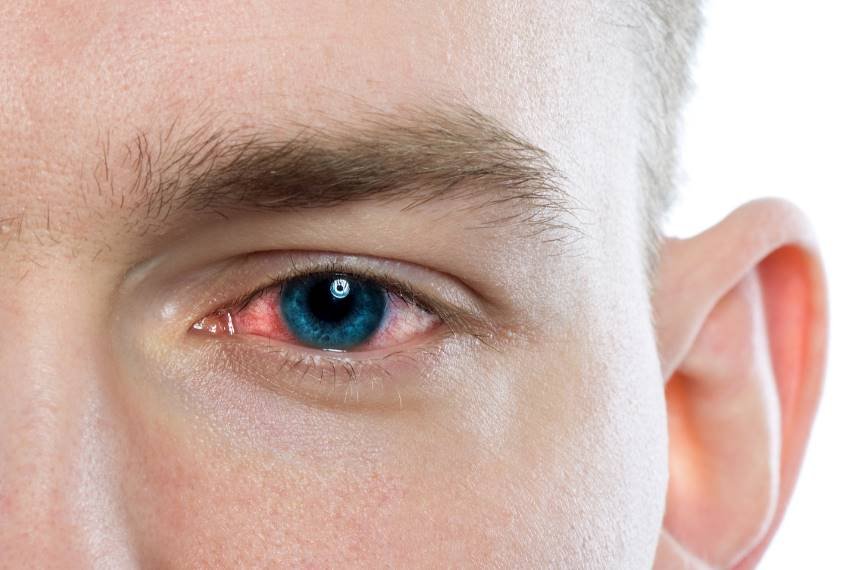If your eyes feel itchy, red, and irritated, it may not necessarily be pink eye (conjunctivitis). Other conditions can cause similar symptoms. This blog will discuss these commonly misdiagnosed conditions, such as allergies, dry eye syndrome, iritis, keratitis, stye, and blepharitis.
We will also help you accurately identify pink eye symptoms and provide information on signs for any eye disorder. Lastly, we will answer frequently asked questions about pink eye. So before panicking about conjunctivitis, let’s gather all the information to understand what might be happening with your eyes.
What is Commonly Misdiagnosed as Pink Eye?
Conditions often mistaken for pink eye include allergic conjunctivitis, dry eye syndrome, blepharitis, viral keratitis, uveitis, and contact lens-related issues. Allergic conjunctivitis has similar symptoms to pink eye but is caused by allergens. Dry eye syndrome causes dryness and irritation, resembling pink eye but requires different treatments.

Blepharitis, inflammation of the eyelids, can also cause redness and discharge, leading to confusion with pink eye. Viral keratitis is a viral infection of the cornea that produces similar symptoms but requires distinct treatment. Eye irritation from contact lens wear can be misdiagnosed as pink eye and may require adjustments in lens use or care to alleviate symptoms.
Allergies in Eye & Eyelashes
Differentiating between allergies and pink eye is crucial. Allergies can cause redness, itching, and tearing of the eyes, similar to pink eye symptoms. Allergic conjunctivitis, triggered by allergens like pollen or pet dander, can lead to swollen eyelids and a burning sensation in the eyes.
If you experience these symptoms, consult a healthcare professional for an accurate diagnosis. Remember that allergies and pink eye require different treatments. Prioritize your eye health and seek proper care from an ophthalmologist.
Dry eye syndrome
Dry eye syndrome and pink eye share similar symptoms such as redness, itching, burning, and blurry vision. However, it’s important to differentiate between the two as their treatment approaches vary.
To accurately diagnose and treat these conditions, consult an ophthalmologist specialising in eye care. An ophthalmologist can properly understand the underlying cause and provide appropriate treatment and management tips.
Iritis
Inflammation of the iris, known as iritis, is characterized by symptoms such as eye redness, pain, sensitivity to light, and blurred vision. Although it can be confused with pink eye due to shared symptoms, iritis necessitates a distinct treatment approach.
When experiencing these symptoms, seeking an accurate diagnosis from an eye doctor is crucial to maintain optimal eye health. Identifying iritis promptly is vital for preventing potential complications and receiving the appropriate care.
Keratitis
Inflammation of the cornea, known as keratitis, can lead to redness, pain, and blurred vision. It is often misidentified as pink eye due to shared symptoms like irritation and redness. However, it necessitates a distinct treatment approach.
Therefore, it is essential to consult an ophthalmologist promptly if you experience discomfort, eye redness, or other signs of keratitis. Seeking accurate diagnosis and appropriate treatment are crucial for the management of this condition.
Stye
A stye, also known as a hordeolum, is a painful bump that occurs along the edge of the eyelid. It is caused by the blockage of oil glands and is not contagious like pink eye. Symptoms include redness, swelling, and discomfort in the affected eye.
Treatment involves warm compresses and proper eye hygiene. If the stye persists or worsens, medical intervention may be necessary. Distinguishing between a stye and pink eye is important for proper care and management.
Blepharitis
Blepharitis is a prevalent eye condition that is frequently confused with pink eye (conjunctivitis). It is marked by inflammation of the eyelids, which is commonly caused by bacteria or skin conditions like dandruff or rosacea.
Symptoms of blepharitis encompass redness, itching, swelling, and a gritty feeling in the eyes. Unlike pink eye, blepharitis is not contagious to others. Treatment options for this condition often involve the use of warm compresses, gentle cleaning of the eyelids, and prescribed medication, which may include antibiotics or steroid creams.
How to identify pink eye symptoms
Pink eye, or conjunctivitis, shares symptoms with other eye disorders like allergies, dry eye syndrome, and infections. Identifying pink eye can be challenging without professional guidance.
Symptoms include redness, itchiness, irritation, discharge, discomfort, swollen eyelids, and occasionally blurry vision or light sensitivity. Consult a healthcare professional for an accurate diagnosis and treatment. Good hygiene and avoiding contact with infected individuals are important to prevent the spread of conjunctivitis.
Signs to look out for in any eye disorder
Eye disorders can be easily misdiagnosed due to similar symptoms shared with pink eye, or conjunctivitis. Redness, itchiness, and discomfort are common signs observed in various eye conditions, including allergies, dry eye syndrome, or corneal abrasions. Bacterial or viral infections can also lead to symptoms resembling pink eye.
Seeking medical attention is crucial if symptoms persist or worsen despite home remedies for pink eye. Identifying the underlying cause is essential to ensure proper treatment and prevent any potential complications.
Are pink eye and conjunctivitis the same?
Yes, pink eye and conjunctivitis are interchangeable terms that refer to the inflammation of the conjunctiva. This condition can be caused by various factors such as infections, allergies, or irritants. Symptoms typically include redness, itching, tearing, and discharge from the eye.
How can I treat pink eye at home?
While it is crucial to seek professional medical advice for a proper diagnosis and treatment of pink eye, there are some home remedies that can offer relief. Applying warm compresses to the affected eye can alleviate irritation and redness, while practicing good hygiene by frequently washing hands and avoiding touching or rubbing the eyes can help prevent further spread of the infection.
How long will it take for my pink eye to heal?
The healing time for pink eye can vary depending on the cause and severity. Viral conjunctivitis typically resolves within 1-2 weeks, while bacterial conjunctivitis may require antibiotics and clears up within a few days to a week. Allergic conjunctivitis can last as long as the allergen is present but can be managed with antihistamine eye drops and avoiding triggers.
Signs that you are eating too much sugar
Excessive sugar consumption can harm your eye health, leading to symptoms commonly mistaken for pink eye. These symptoms include redness, swelling, itching, irritation, and blurry vision. Sugar can cause dry eyes and conjunctival inflammation, resembling pink eye. Properly recognizing these indicators is crucial to avoid incorrect treatment and unnecessary discomfort.
Get our BEST updates delivered to your inbox
Pink eye, or conjunctivitis, causes redness and inflammation of the conjunctiva. However, other eye conditions can have similar symptoms and be mistaken for pink eye. Allergic conjunctivitis, inadequate tear production, rapid tear evaporation, and infections of the eyelid or surrounding tissues can imitate pink eye symptoms. It’s important to seek medical attention for an accurate diagnosis and treatment.
Conclusion
In conclusion, there are several conditions that can be misdiagnosed as pink eye, including allergies, dry eye syndrome, COVID pink eye, iritis, keratitis, stye, and blepharitis. It’s important to be aware of the specific symptoms and signs associated with each condition in order to receive an accurate diagnosis and appropriate treatment. If you suspect you have pink eye or any other eye disorder, it is always best to consult with an ophthalmologist for a proper evaluation. For more information on pink eye and other eye-related topics, sign up for our newsletter to receive our best updates directly to your inbox.





















